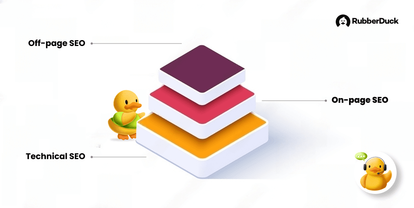Understanding SEO in 5 minutes
By: RubberDuck Team
July 04 2023
Having a basic understanding of how search engine optimization works will provide a great start for you if you plan on doing it yourself for your own website or if not, it will help you avoid scams or exaggerated promises.
More than 200 elements of your website are factored in and calculated in the search engine algorithms such as the one for Google Search. Those elements are balanced in a way that it’s very hard to game the system.
It is important to know that the goal of the algorithm is to ponder what website is the most relevant to show in the search results for each individual user, so that he has the best possible experience. Considering countless factors such as the keywords he used when he Googled it, the time of the day, or his location in the world at that time, the algorithm’s only goal is to find the best answer to the following question: Will that user find what he is looking for if he is presented with website X?
Having a basic understanding of how search engine optimization works will provide a great start for you if you plan on doing it yourself for your own website. On the other hand, if you do not plan on doing this yourself, it will provide you with a solid knowledge in the matter, therefore making sure you do not get scammed by someone promising you extraordinary results based on a couple of backlinks they want to sell you.

The Pyramid
The idea of presenting these SEO factors with a pyramid structure is not fortuitous. We could have chosen a tree, with its roots reaching deeply into the ground, or some other cute metaphor to help everybody understand, but none of them convey the precise concept that we want to share with you.
The reasoning behind the use of the pyramid is the idea that you just can’t move up in building your pyramid if you haven’t been through the construction of a solid foundation. You need to build your foundation first if you want to have any chance at getting any favorable result when you move up the stages.
The positive impact of a solid foundation on your results is exponential! Because of that, we would argue that it is unwise to spend any money or resources in building the next stage of your pyramid if the one under isn’t properly completed.

Stage 1 - Technical SEO
Simply said, technical SEO refers to elements that your website’s visitors cannot see. It’s the backend of everything that is going on on your website and it’s largely influenced by the technology you chose to build your website with. A website builder such as RubberDuck is designed to guarantee that this part of your website is 100% compliant with search engines requirements.
Technical SEO forms the foundation of a website's SEO strategy by ensuring that search engines can efficiently crawl, index, and rank the website's content. By optimizing technical elements like website speed, mobile-friendliness, indexing, crawling, site architecture, and structured data, technical SEO enhances search engine visibility and user experience.
It sets the stage for effective and exponential on-page and off-page SEO strategies, ultimately driving organic traffic and improving search engine rankings.
Stage 2 - On-page SEO
In short, On-page SEO refers to what visitors can see and experience on your website. Of course, the content is a big part of it, with the right choice of keywords and the weekly blog posts, but it’s also about the visitor’s behavior while they navigate your website. How long do stay on the website? How many pages do they browse? Do they need to access other search results on Google to find what they were looking for?
For instance, if a website has slow page load times due to unoptimized code or large file sizes, it will negatively impact the user experience who might quit the website quickly and send wrong signals to the algorithm. If the content is not relevant to the subject or does not answer his particular question accurately, he will keep browsing other search results to get his answer.
Stage 3 - Off-page SEO
Off-page SEO is all the signals sent to the algorithm for activities that take place outside of your website. It’s mostly about your website’s authority, relevance, and popularity on a subject. You do this by having other high-quality websites talk about your website and add a link to it, a process called link building or backlinking.
Backlinks serve as votes or endorsements for a website's content, indicating its credibility and value to search engines. Major media outlets, big reputable websites, social medias, blogs and directories provide most of the quality backlinks on the web.
Web marketing, paid search advertising and social media sponsored publicity, because they drive traffic to a website, are also an important part of off-page SEO signals influencing the algorithms.
Conclusion
Whether you handle SEO yourself or hire professionals, basic understanding is essential to avoid scams or exaggerated promises. A comprehensive SEO strategy encompasses technical SEO, on-page SEO, and off-page SEO but you must always keep this pyramid in mind and remember that results you will get in the upper tiers of the pyramid are exponentially influenced by the work that has been done in the lower tiers.
Finally, make sure you select a website building technology, such as RubberDuck, that guarantees the foundations of your website are solid and compliant with search engines requirements.

